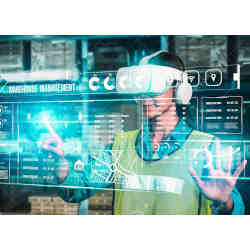
Recent trends have presented major challenges to warehouses and distribution centers. According to data from the U.S. Census Bureau and Department of Commerce, the e-commerce share of retail sales has risen from 10.5% at the beginning of 2019 to 13% this past quarter, with a spike to 15.7% in Q2 2020. That increase has put pressure on those facilities to increase efficiency and speed.
At the same time, the warehouse sector has been wrestling with a labor shortage. According to the Bureau of Labor Statistics, job vacancies in the U.S. warehousing and storage sector reached or exceeded 5% of the total number of jobs in the sector throughout 2021, representing some 75,000 jobs unfilled.
There are differences between warehouses and distribution centers: the former are used for longer-term storage and inventory building, while the latter are better suited to high-velocity, quick-turnaround operations. The bottom-line need for both is knowing where their stuff is, where it needs to go, and how to get it there.
"At a basic level, it's asset tracking," says Srini Samudrala, senior vice president for Digital and Internet of Things for Zyter, a Rockville, MD-based company that describes itself as a "digital health and IoT-enablement platform." Says Samudrala, "If you think about it, about 70% of all use-cases in the IoT world are around tracking the location of something."
Both kinds of facilities are addressing the challenges of such tracking through increased use of "smart" technologies such as machine vision, artificial intelligence, and the Internet of Things, along with autonomous and supervised robotics. According to market research firm ABI Research, over 4 million commercial robots will be installed in over 50,000 warehouses by 2025, a significant increase from the 4,000 robotic warehouses the company tracked in 2018.
Seizing the opportunity
Companies new and old, small and large, are working to establish themselves in the smart warehouse and distribution center market. Honeywell, for example, introduced its Honeywell Universal Robotics Controller (HURC) in 2020, after the company had already rolled out an autonomous robotic unloader. "We thought, 'Hey, we have these various aspects of robot control, we're interfacing with multiple sensors, we're making algorithms that make those hardware systems and products smart'," recalls Thomas Evans, Chief Technology Officer of Honeywell Robotics. "'Let's bring this into an overall universal robotic controller so we don't have to duplicate that effort. And then modularize it, so we can adapt to other hardware platforms or other systems'."
In a white paper titled Breakthrough Robotics Empowering Distribution Centers, Honeywell points to five key technologies in which advances have made a new generation of storage and distribution industry robots possible:
- sensors and vision, including three-dimensional (3D) cameras and LiDAR;
- machine learning and artificial intelligence (AI), which let robots solve problems independently;
- connectivity via the cloud;
- computing power, and
- mobility.
The idea is that using these technologies, robots will be able to address warehouse issues on their own, while humans continue to direct training operations. The tasks Honeywell sees the robots performing include loading and unloading, picking items, sorting them, and putting them on pallets.
"The product we just released is the smart flexible depalletizer," says Evans. "Products come in on pallets; they can be products that look the same or look completely different. The robotic system uses machine vision to distinguish between two packages and say, 'I'm just going to pick this one and put it on the conveyor.' It also learns from that; it says, 'I was successful on this pick, and the image that I was successful with looks like this.' It builds that repository of information that robot could then draw more inferences from."
Another company active in the space is Qualcomm, whose Smart Cities Accelerator Program is part of a strategic collaboration with Zyter's SmartSpaces IoT platform. "We do not make devices at all," explains Zyter's Samudrala, "which is where the relationship with Qualcomm benefits both of us." Other members of Qualcomm's program provide the trackers, cameras, and sensors that Zyter uses to implement smart warehouses.
"We have a platform with multiple different components in it, but we don't just come in with a platform. We are pre-integrated with a number of devices to convert their data and their protocols into our ever-growing data model." Zyter's platform currently embraces more than 200 different devices in its ecosystem, says Samudrala.
Like Honeywell's HURC, Zyter's SmartSpaces is modular. "It's just a bunch of Lego bricks, and you can put them together to build whatever solution you want," he says. "If you want just basic asset tracking, Zyter can give you that; here is the device, here's the app. That's one of our foundational modules.
"We also do automated inventory management: knowing how many things you have in the warehouse, and more importantly, where they are stored," Samudrala says. "We enable indoor navigation, so you can go out and find them, and tell you if objects are not in the right place, when items have come into the inventory, when they have left, and whether that was supposed to happen or not."
SmartSpaces uses analytics to help warehouses move beyond simply knowing what and where things are to predicting future needs. "Some of the analytics that we're doing today are going from descriptive to predictive to even prescriptive, primarily driven by analytics and a supervised learning process," says Samudrala.
One example of a warehouse project on which Qualcomm and Zyter is collaborating is a current effort for OneScreen, a San Diego, CA-based vendor of video collaboration products. The project will involve autonomous mobile robots, augmented and virtual reality tools, and IoT sensors, all working with a warehouse management system. OneScreen's problem was "how do we track all the inventory that is in the warehouse?" says Samudrala. "And how do we manage that inventory better based on the orders coming in, the history of all the orders, and so on. We know how much inventory they have to fulfill an order, and we are also getting the data from orders to determine if the inventory is able to meet the orders that are coming in, and then starting the process of getting on fulfilling the items."
Smart and transparent
As for the outlook for the category, "Obviously, robotics are going to get more complex," says Honeywell's Evans. "Customers are constantly changing the way they operate, not by choice. They want visibility into how the software is performing: data dashboards and user interfaces. We need to be very flexible with HURC to make sure we're providing the right updates to our software."
Jake Widman is a San Francisco, CA-based freelance writer focusing on connected devices, Smart Homes and Cities, Extended Reality, and other emerging technologies.



Join the Discussion (0)
Become a Member or Sign In to Post a Comment